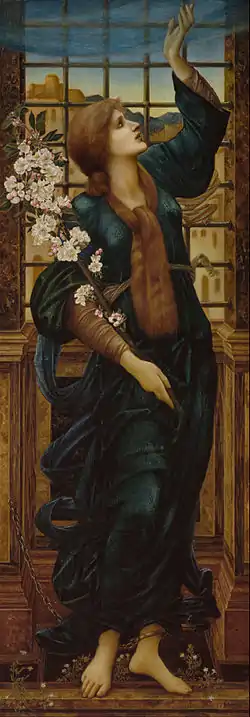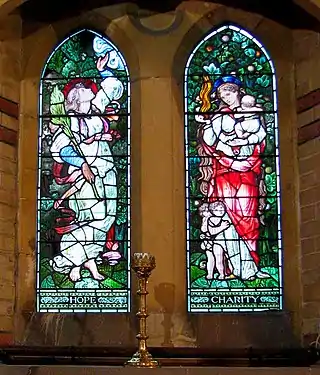Hope (Burne-Jones)
Hope is a late oil painting by the Pre-Raphaelite artist Edward Burne-Jones. It was painted on commission for Mrs. George Marston Whitin of Whitinsville, Massachusetts in 1896.[1][2]
| Hope | |
|---|---|
 | |
| Artist | Edward Burne-Jones |
| Year | 1896 |
| Type | oil painting |
| Dimensions | 179 cm × 63.5 cm (70 in × 25.0 in) |
| Location | Museum of Fine Arts, Boston |
Mrs. Whitin originally requested a painting of a dancing figure, but Burne-Jones, devastated by the recent death of his long-time friend and partner William Morris, struggled with the work and wrote to ask if a painting of Hope would be an acceptable alternative. The result was an allegory in the Renaissance fashion, with the bound personification of Hope reaching skyward despite her bars.[3][4]
The painting is based on an 1871 watercolour by Burne-Jones. The watercolour is likely painted over the original cartoon for one of a set of stained glass designs of the Christian virtues Faith, Hope, and Charity created by Burne-Jones for Morris, Marshall, Faulknor and Company. A three-light window based on Burne-Jones's designs was commissioned for the nave of Christ Church Cathedral, Oxford.[3][4] The stained glass designs were also used for a set of windows at St Margaret's Church, Hopton-on-Sea, Norfolk and St Martin's Church, Brampton, Cumbria.
The oil painting of Hope was donated to the Museum of Fine Arts, Boston by Mrs. Whitin's daughters in her memory.[1]
Other versions
.jpg.webp) Watercolour, 1871, Dunedin Public Art Gallery
Watercolour, 1871, Dunedin Public Art Gallery Stained glass window (left), St Margaret's Church, Hopton-on-Sea
Stained glass window (left), St Margaret's Church, Hopton-on-Sea
See also
Hope, an oil painting by the English painter George Frederic Watts (1886)
References
Notes
| External video | |
|---|---|
Bibliography
- Wildman, Stephen (1998). Edward Burne-Jones: Victorian Artist-Dreamer. Metropolitan Museum of Art. ISBN 0870998595.